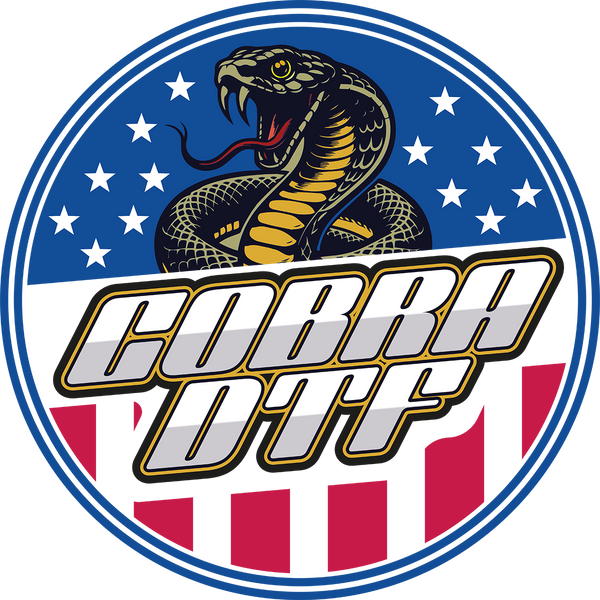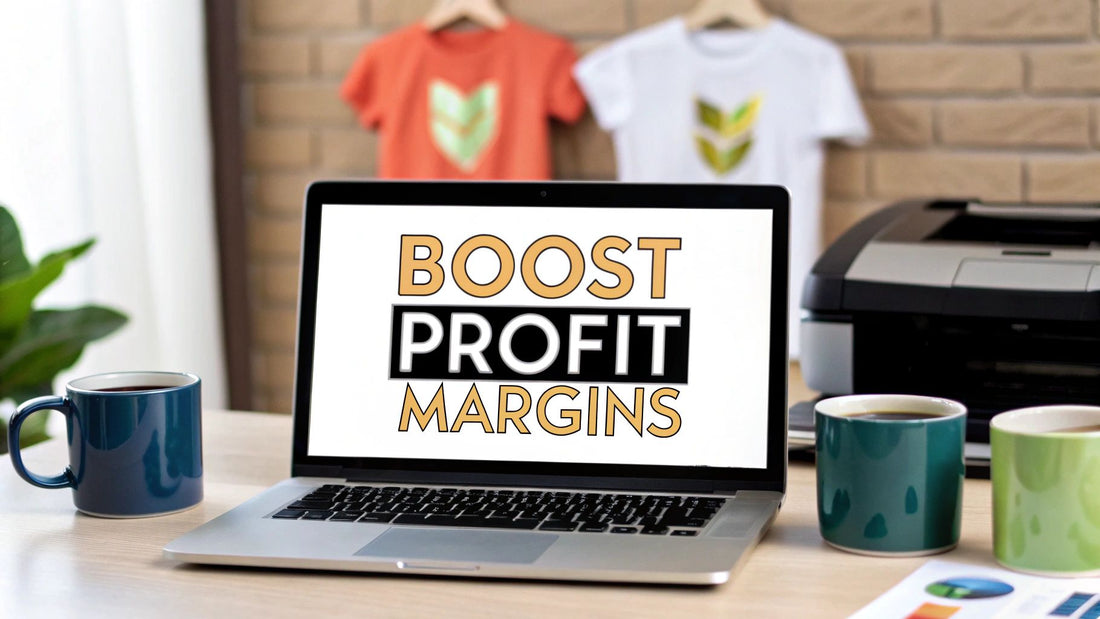
Boosting Your Print On Demand Profit Margins
Share
So, what does a healthy print on demand profit margin actually look like? In my experience, a solid target to aim for is somewhere between 15% and 30%.
This isn't just a random number; it's the financial breathing room that separates a thriving online store from a side-hustle that barely breaks even. This is the money left over after you’ve paid for the product itself and the fulfillment service. Hitting this target is crucial.
Unpacking Your Potential Earnings
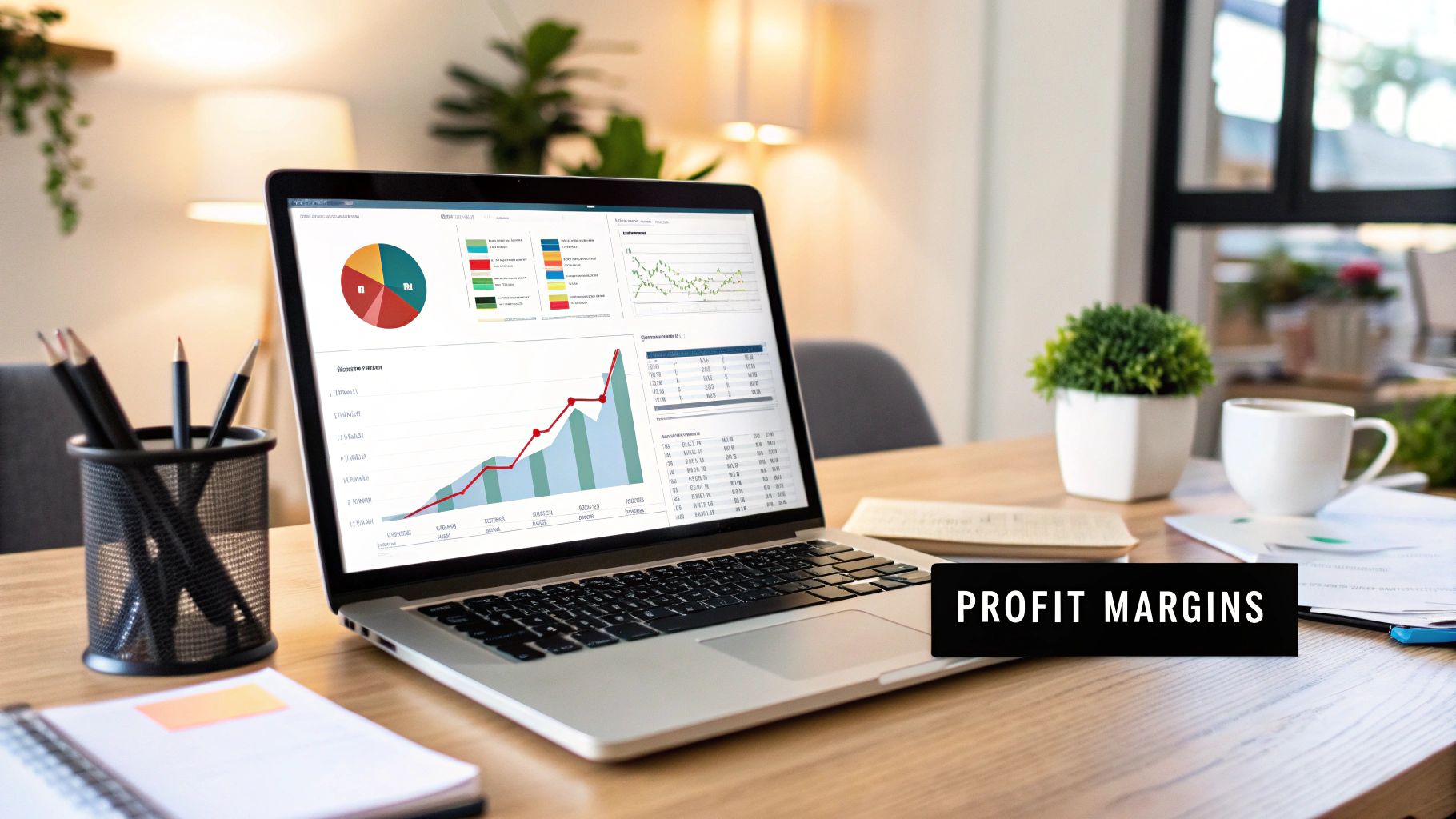
Think of your profit margin as the piece of the pie you actually get to keep from every single sale. It’s the percentage of revenue left after your POD partner takes their cut for the blank product, the printing, and the shipping.
Let's use a simple example: you sell a t-shirt for $25. The total cost from your supplier is $15. That leaves you with a $10 gross profit. To get the margin, you just divide that profit by the sale price: $10 / $25 = 40%.
That 40% is your gross profit margin. But remember, the true measure of your business's health is your net profit margin. That number will be lower once you subtract things like marketing costs, platform fees, and other overhead. This is where knowing the industry benchmarks really helps you stay on track.
Setting a Realistic Target
The print on demand model has a huge advantage over traditional retail. While many physical product businesses struggle with margins under 20% (and often below 10%), POD sellers can consistently hit that 15% to 30% sweet spot.
How is this possible? Simple: you carry zero inventory. With no upfront costs for stock, you can price your unique designs at a premium, allowing you to build a profitable business even in a crowded market. If you're curious about the bigger picture, you can explore more print on demand statistics to see how the industry is performing.
This 15% to 30% range is your goal. Dip below it, and your business might not be sustainable long-term. Climb above it, and you're well on your way to building a seriously profitable brand.
The Bottom Line: Your profit margin is more than just a number—it’s the pulse of your business. It shows how efficiently you’re turning sales into real, take-home profit that you can either reinvest or pay yourself with.
Typical Profit Margins for Popular POD Products
To give you a clearer idea of what to expect, here’s a quick look at the typical margins for some of the most common print on demand products. These are just estimates, of course, but they provide a great starting point.
| Product Type | Average Base Cost | Typical Retail Price | Estimated Profit Margin |
|---|---|---|---|
| T-Shirt | $10 - $15 | $24 - $30 | 40% - 60% |
| Hoodie | $20 - $28 | $45 - $60 | 50% - 60% |
| Coffee Mug | $5 - $8 | $15 - $20 | 50% - 70% |
| Poster | $8 - $12 | $20 - $28 | 55% - 65% |
| Phone Case | $9 - $13 | $20 - $25 | 45% - 55% |
| Tote Bag | $10 - $14 | $22 - $28 | 50% - 60% |
As you can see, items like mugs and posters can have surprisingly high margins, while apparel tends to be a bit lower but often sells in higher volumes. Balancing your product catalog is key to maximizing your overall profitability.
Why This Number Matters So Much
A solid understanding of your margins empowers you to make smarter decisions everywhere in your business. It tells you exactly how much you can spend on ads, what kind of sales you can run without losing your shirt, and when it’s the right time to add new products to your store.
Ultimately, a firm grasp on your print on demand profit margins puts you in the driver's seat. You can price your products with confidence, choose the right suppliers for your goals, and build marketing campaigns that actually deliver a positive return. Without this knowledge, you’re just guessing—and hoping for the best is not a business strategy.
Calculating Your True Profit Margin
If you want to run a successful print on demand business, you absolutely have to know your numbers. It’s a common pitfall to just subtract the product cost from your selling price and call it a day, but that simple math leaves you totally in the dark about the other expenses quietly draining your earnings.
To really understand the financial health of your store, you have to look at the whole picture.
Think of it like baking a cake. You’d never just count the cost of flour and sugar. What about the eggs, the vanilla extract, the electricity for the oven, and even the box you put it in? Every single ingredient matters. The same goes for your business—every little cost affects your final profit.
This visual breaks down how to get from your sale price to your actual, take-home profit.
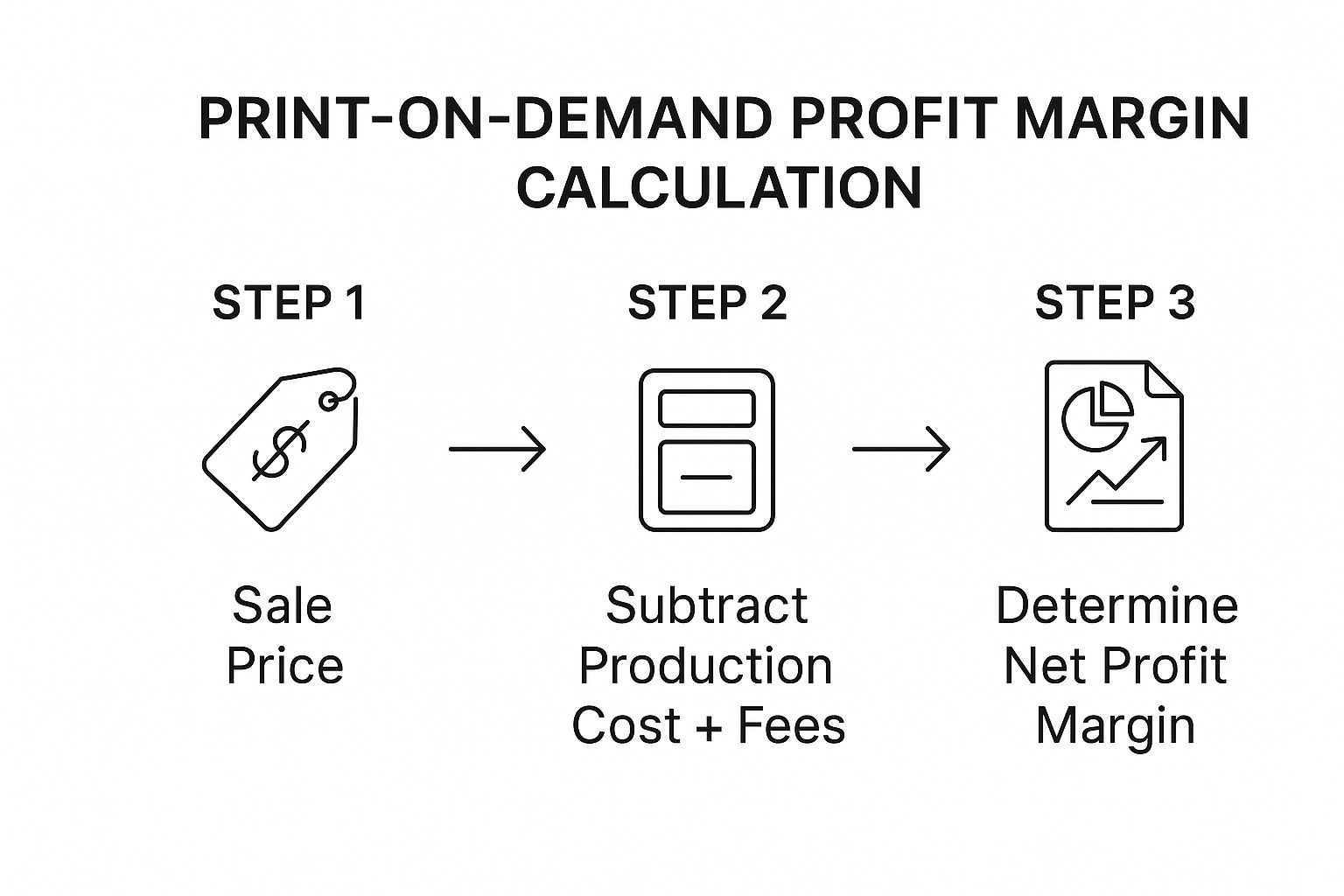
As you can see, your real profit is what’s left after all the production costs and various fees have been subtracted from what the customer paid.
Beyond the Base Cost
The base cost from your POD supplier is just the starting line. To get a true sense of your profitability, you must account for every variable cost tied to a sale—these are the expenses that crop up each time an order comes through.
Let's break down these often-forgotten costs:
- Product Base Cost: This is what your supplier, like Printful or Printify, charges for the blank item and the printing itself.
- Shipping Fees: The cost to get that product from the supplier's warehouse to your customer's doorstep.
- Marketplace Transaction Fees: Platforms like Etsy, Amazon, or even Shopify Payments take a slice for processing the payment. This is usually around 2.9% + $0.30.
- Listing Fees: Some marketplaces, most famously Etsy, charge a small fee (like $0.20) just to list or renew an item in your shop.
- Marketing & Ad Spend: Don't forget this one! If you run ads on Facebook, Google, or TikTok, you need to figure out how much you spent on average to get that specific sale.
Add all of these up, and you get your Total Cost of Goods Sold (COGS). This figure is the real cost to produce and sell one item.
The Big Idea: Your real profit isn't just the retail price minus the supplier's fee. It's what's left after every single variable expense—from platform fees to ad spend—is taken out.
A Real-World T-Shirt Example
Okay, let's make this tangible. Theory is one thing, but seeing the numbers in action makes it all click. We'll walk through a realistic scenario for a classic POD product: a t-shirt.
Imagine you're selling a custom-designed t-shirt on your store.
1. Your Selling Price
You’ve done your research and priced your t-shirt at a competitive $30.00. This is the top-line revenue you start with.
2. Calculating Your Total Costs
Now for the fun part—let's add up every single expense that went into making this one sale happen.
- Supplier Base Cost: $12.50 for a good quality t-shirt.
- Shipping Cost: $4.50 for standard shipping.
- Platform Fee (Shopify Payments): (2.9% of $30) + $0.30 = $1.17.
- Marketing Cost Per Sale: Let's say you spent $50 on an ad campaign that brought in 10 sales. Your cost per acquisition for this shirt is $5.00.
Now, let's sum it all up:
$12.50 (Base) + $4.50 (Shipping) + $1.17 (Fee) + $5.00 (Ads) = $23.17 Total COGS
3. Determining Your Net Profit and Margin
With our true costs figured out, we can finally see the profit you actually bank.
- Net Profit: $30.00 (Retail Price) - $23.17 (Total COGS) = $6.83
- Net Profit Margin: ($6.83 / $30.00) x 100 = 22.7%
In this scenario, your 22.7% net profit margin is solid, landing right in the healthy industry benchmark of 15-30%. This is the kind of detailed math that gives you the power to price products smartly, manage your ad spend, and make the right moves to actually grow a profitable business.
Key Factors That Control Your Profitability
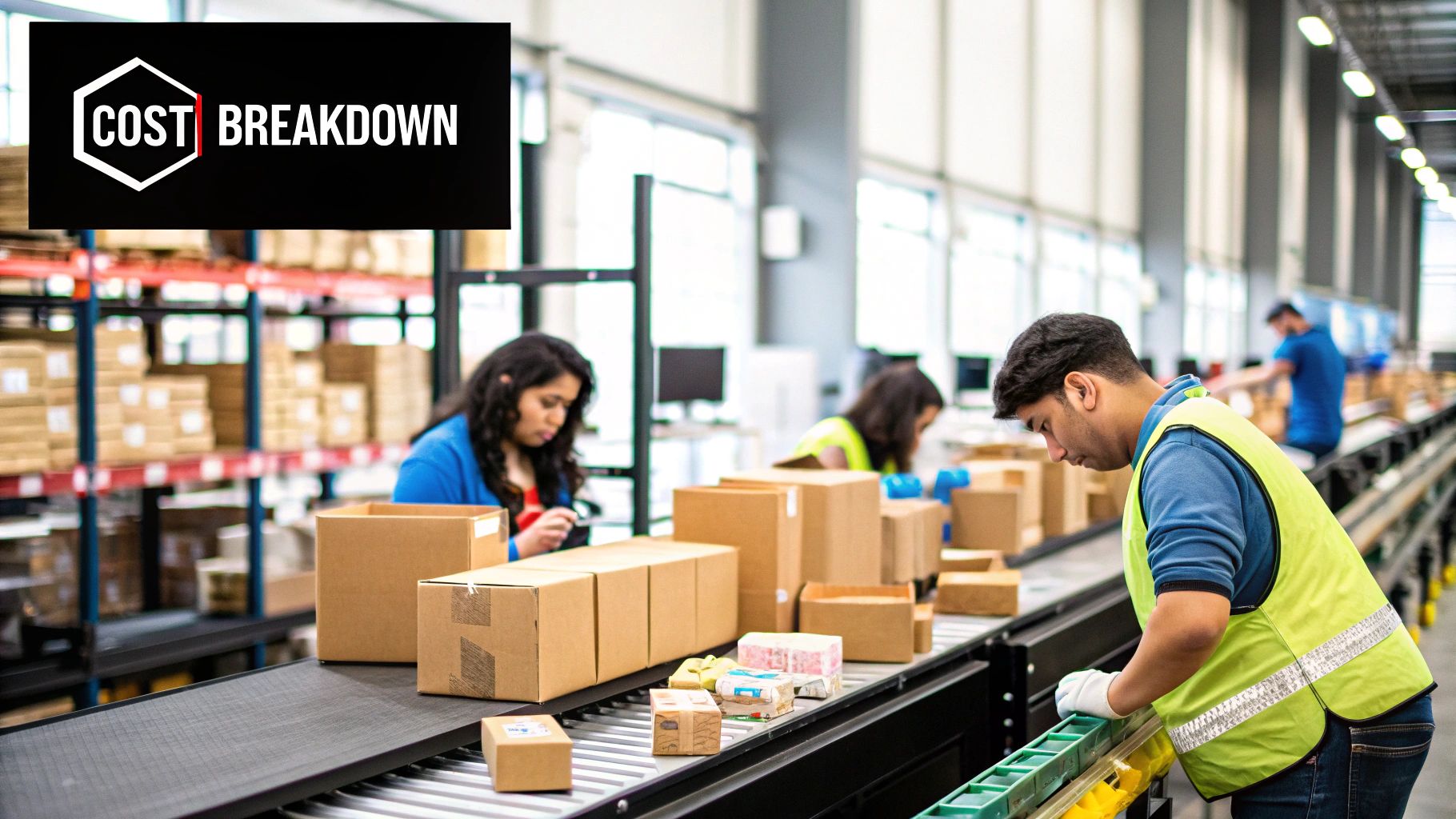
Your print on demand profit margins aren't set in stone. Think of them less like a fixed number and more like the output on a sound mixing board. You have a series of faders—product choice, design, supplier—and every little adjustment you make changes the final sound, or in this case, your take-home pay.
Mastering these controls is what separates a struggling side-hustle from a truly profitable brand. Let's break down the most critical levers you can pull to start shaping your own financial success.
Product Quality And Selection
It all starts with the blank canvas. Opting for the absolute cheapest t-shirt or mug to save a few bucks might seem smart, but it's a classic rookie mistake that almost always backfires. Low-quality products feel cheap, they don't last, and they lead to a storm of customer complaints and returns—all of which bleed your profits dry.
On the flip side, choosing premium-quality products gives you immediate pricing power. A super-soft, eco-friendly hoodie simply feels more valuable than a standard, scratchy one. This higher perceived value justifies a higher price tag, allowing you to bake a healthier margin into your pricing from day one.
- A standard cotton tee might sell for $22, netting you a $6 profit.
- A premium tri-blend tee could sell for $30, earning you a $10 profit.
That simple choice can make a huge difference in your earning potential on every single sale.
The Uniqueness Of Your Designs
In the crowded POD marketplace, your designs are your superpower. Generic artwork and tired, overused slogans force you into a brutal price war—a race to the bottom where nobody really wins. Anyone can slap "I Love Coffee" on a shirt, so the only thing left to compete on is who can sell it for a dollar less.
This is where unique, niche-specific designs completely change the game. When you create art that speaks directly to a passionate community—like urban beekeepers or vintage synth collectors—you’re offering something they can't get just anywhere.
Unique designs transform a simple commodity into a coveted product. You're no longer just selling a shirt; you're selling identity, art, and a connection. That allows you to price based on value, not just cost.
Your Choice Of POD Supplier
Make no mistake: your choice of a print on demand partner will have a massive impact on your bottom line. It's about so much more than just the base cost of a product. You have to look at the whole picture—shipping costs, print quality, production speed, and overall reliability.
A supplier with a slightly higher base cost but faster, cheaper shipping can actually leave you with more profit per order. A reliable partner also means fewer errors, reprints, and delays, all of which are silent profit killers that can tarnish your brand's reputation. Digging into a guide on the best https://cobradtf.com/blogs/guides/print-on-demand-suppliers is time well spent before you commit.
To see just how much this matters, let's compare two hypothetical suppliers for the same t-shirt sold at the same retail price.
How Supplier Choice Impacts T-Shirt Profit Margin
| Metric | Supplier A (Budget) | Supplier B (Premium) | Impact on Profit |
|---|---|---|---|
| T-Shirt Base Cost | $9.00 | $12.00 | Supplier B is $3 more expensive upfront. |
| Shipping Cost | $6.50 | $4.50 | Supplier B's faster shipping saves you $2. |
| Total Fulfillment Cost | $15.50 | $16.50 | The total cost difference is now only $1. |
| Refund Rate Due to Quality | 5% | 1% | The hidden cost of returns eats away at Supplier A's profits. |
As you can see, the "cheaper" option on paper might not be the most profitable one in the real world. Once you factor in all the variables, the premium supplier often provides better value and protects your margins in the long run.
Strategic Pricing to Maximize Earnings
Pricing is the single most powerful lever you can pull to control your print on demand profit margins. So many sellers get stuck in the "cost-plus" trap, where they just take the supplier's base cost and tack on a few bucks. This approach treats your unique designs like they're a dime a dozen and leaves a ton of money on the table.
To really maximize your earnings, you have to stop guessing your prices and start architecting them with a clear strategy. This isn't just about math; it's about understanding the psychology of value. Your price tag is more than a number—it’s a powerful signal to customers about the quality of your product and the creativity behind your design.
Moving Beyond Cost-Plus Pricing
The most successful print on demand sellers use a strategy called value-based pricing. Instead of asking, "What's the absolute minimum I can charge to make a profit?" they flip the script and ask, "What is this unique design worth to my ideal customer?" That simple change in perspective is a total game-changer.
Think about it. A generic t-shirt with a stock graphic might only fetch $20. But a brilliantly designed shirt for a passionate niche—say, rock climbing enthusiasts or fans of a specific video game—could easily sell for $30 or more. The physical t-shirt is the same, but the perceived value is worlds apart.
This is where your unique designs and strong brand become your greatest assets. You're not just selling fabric; you're selling a statement, an identity, and a piece of wearable art. That value comes from your creativity, not the supplier's base cost. Getting this is the first step to unlocking much higher profit margins.
Your designs are what turn a $10 blank t-shirt into a $30 premium product. Price it that way. When you focus on the value you provide, you disconnect your pricing from the raw cost and tie it to what your customers are genuinely willing to pay.
Harnessing Psychological Pricing Tactics
Once you’ve set a value for your product, you can use subtle psychological tactics to make your prices even more appealing. These aren't sneaky tricks; they’re proven methods used by major retailers everywhere to gently nudge customers toward making a purchase.
One of the most common is charm pricing, which just means ending your price with a 9 or 99. Our brains are wired to see $24.99 as significantly cheaper than $25.00, even though it's just a one-cent difference. This tiny adjustment can give you a measurable bump in conversions without really hurting your margin. Of course, the quality of your prints plays a big role in justifying these prices; understanding different methods can help. For an in-depth comparison, check out this guide on the differences between DTF vs DTG printing.
A few other effective psychological strategies include:
- Price Anchoring: Show a higher "original" price next to your current one (e.g., "Was $35, Now $28"). This makes the current price look like a much better deal.
- Tiered Pricing: Offer "Good," "Better," and "Best" options. Think a standard tee, a premium tee, and a hoodie all with the same design. This often steers people toward the middle, higher-margin choice.
Running Promotions Without Devaluing Your Brand
Sales and promotions are fantastic for driving traffic and moving inventory, but you have to be careful. Constant, deep discounts can train your customers to just wait for a sale, which cheapens your brand and eats away at your long-term profits.
Instead of running a never-ending "50% Off" sale, get strategic with promotions that create a sense of urgency without making your products seem cheap.
- Limited-Time Offers: A 24 or 48-hour flash sale is great for encouraging people to buy now.
- Bundle Deals: Offer a discount for buying multiple items, like "Buy 2 Shirts, Get 1 50% Off." This increases your average order value while moving more product.
- Holiday & Event-Based Sales: Tie your promotions to specific holidays or events that make sense for your niche. This makes the sale feel special and timely, not just random.
By pricing based on value, using smart psychological tactics, and running promotions with a purpose, you take direct control of your earnings. This proactive approach ensures you're not just making sales—you're building a sustainable and seriously profitable print on demand business.
Actionable Tactics to Boost Your POD Profits
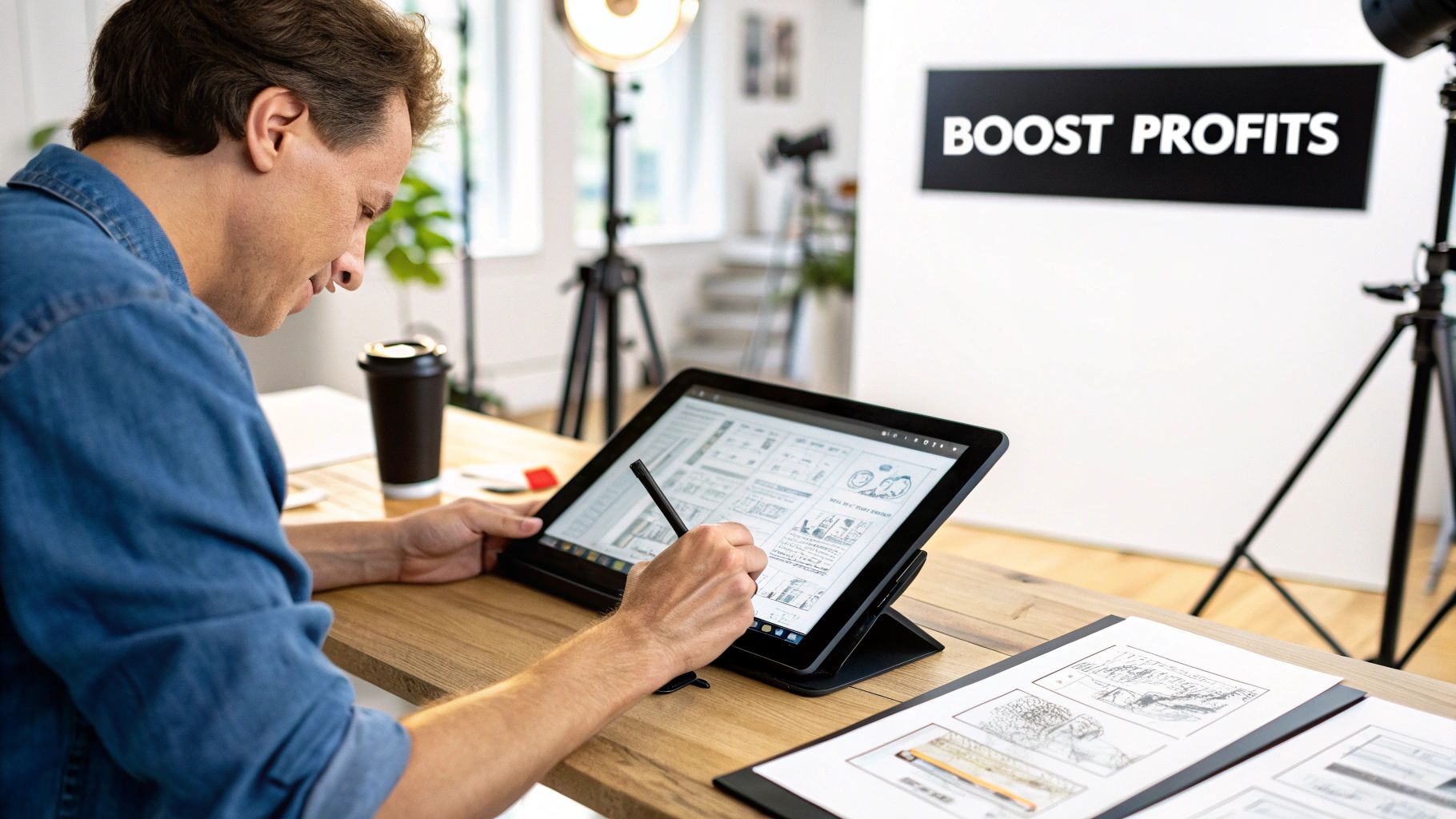
Knowing what shapes your print on demand profit margins is half the battle. Now it’s time for the other half: taking action. This is your playbook, filled with practical strategies you can put into motion today to strengthen your bottom line and pocket more of your revenue.
These aren't just high-level theories; they're tangible operational tweaks. Each one might seem like a small adjustment on its own, but when you combine them, the impact on your profitability can be massive. Let's get into the specific moves that separate the top earners from everyone else.
Increase Your Average Order Value
One of the fastest ways to make more money without chasing down new customers is to simply get each person to spend a little more. The name of the game is boosting your Average Order Value (AOV), and a couple of classic retail tactics work wonders here.
-
Product Bundling: Why sell a single t-shirt when you can sell a whole look? Try grouping complementary items—like a t-shirt, hat, and phone case with the same design—and offer them as a package deal. A small discount on the bundle makes the customer feel like they're getting a great deal, and you move more inventory in one go.
-
Upselling and Cross-selling: This is all about the timely suggestion. When a customer adds a standard hoodie to their cart, your store can automatically suggest upgrading to the premium, fleece-lined version (that's an upsell). Or, if they buy a coffee mug, you could show them a set of matching coasters (a cross-sell). It's a simple, low-pressure prompt that can easily add a few extra dollars to that order.
You’ve already done the hard work of getting them to your store. These strategies just maximize the value of their visit.
Order Samples to Reduce Returns
Returns are the silent killers of profit. Every time you process a refund, you don’t just lose the profit from that sale—you also lose the ad money you spent to get that customer in the first place. A huge reason for returns in the POD world is a simple mismatch between what the customer thought they were getting and what showed up at their door.
The fix is straightforward: always order samples.
Before a new product ever goes live on your site, get one in your own hands. Feel the t-shirt fabric. See how vibrant the colors really are on that mug. Run it through the wash and see if the design holds up. This is non-negotiable quality control. It ensures you're selling something you can confidently stand behind, which nips potential complaints and returns in the bud.
Think of ordering samples not as an expense, but as an investment in customer satisfaction and margin protection. The money saved from preventing just one return can often pay for the cost of several samples.
Optimize Your Supplier Network
Your choice of a POD supplier directly hits two of your biggest expenses: the base cost of the product and the shipping fees. A little strategic thinking here can make a huge difference to your print on demand profit margins.
Consider making these moves:
-
Pick Suppliers Close to Your Customers: If your main customer base is in the United States, it makes zero sense to use a supplier in Europe or Asia. Sourcing from a US-based partner will slash shipping costs and delivery times. Faster, cheaper shipping means happier customers and more money left over for you.
-
Mix and Match Suppliers: Don't feel locked into a single partner. One supplier might have the absolute best price and quality for t-shirts, but another might be the go-to for fantastic mugs or posters. Building a small network of trusted suppliers allows you to route each order to the partner who can produce that specific item best.
Build a Powerful Email List
Relying solely on paid ads to find customers is a treadmill you can never get off of—and an expensive one at that. A far more sustainable and cost-effective approach is to build your own audience with email marketing. Your email list is a direct line to your biggest fans, and best of all, you own it.
Start by capturing email addresses on your website. A simple pop-up offering a 10% discount on their first order in exchange for their email is a proven winner. Once they're on your list, you can reach them for free. Announce new designs, run flash sales, and send special promotions without paying a dime to a social media platform. This crushes your customer acquisition cost over time, leaving a much bigger slice of the profit pie for you.
Common Mistakes That Erode Profit Margins
Getting your print on demand profit margins right isn't just about the smart moves you make—it's also about the traps you avoid. I've seen too many sellers watch their earnings evaporate because of a few common, yet incredibly costly, mistakes.
If you want to build a business that lasts, you have to know what those pitfalls are and steer clear of them.
Competing on Price Alone
The first and most common mistake? Trying to be the cheapest shop on the block. When you're in a crowded market, it's so tempting to just undercut everyone else's prices to get a quick sale.
But this is a race to the bottom you simply cannot win. It devalues your creative work, turns your unique designs into commodities, and absolutely demolishes your profit margin. The real win isn't being the cheapest; it's offering something special that a niche audience genuinely wants to buy.
Overlooking Hidden Costs
Another profit-killer is ignoring all the little expenses that add up. It’s easy to look at the supplier's base cost for a t-shirt and call it a day, but that's only a tiny piece of the puzzle.
You have shipping fees, marketplace transaction charges (which are often around 2.9% + $0.30 per sale), and what you spend on marketing to get that customer in the door. If you aren't factoring those in, your "profit" is pure fiction. A product that looks great on paper could actually be costing you money with every order.
The most dangerous expense is the one you don't track. A complete picture of your costs is the only way to protect your profit margin from slowly eroding without you even noticing.
Neglecting Quality Control
Choosing a supplier just because they're a few cents cheaper per item is a classic rookie error with disastrous consequences. Poor print quality, cheap-feeling materials, or wonky sizing will inevitably lead to unhappy customers, bad reviews, and a flood of returns.
Remember, every return doesn't just wipe out the profit from that sale. It costs you more in customer service time, return shipping, and the priceless loss of a potential repeat customer.
The fix is simple: always, always order samples first. Feeling the garment and seeing the print with your own eyes is a tiny upfront investment that saves you from massive headaches later. It's also vital to use durable transfers. You can get a better sense of high-quality options by checking out custom iron-on shirt decals.
By sidestepping these common blunders, you’re doing more than just protecting your bottom line. You’re building a stronger brand, earning customer trust, and laying a solid foundation for a business that can actually grow.
Frequently Asked Questions
Even when you think you have the numbers figured out, a few common questions always seem to pop up once you get your hands dirty. Let's tackle some of the most frequent ones I hear about print on demand profit margins to clear up any lingering confusion.
What's a Realistic Profit Margin for a Beginner?
When you're just starting, a realistic profit margin is going to be in the 10-15% range. Don't let that discourage you. This is your learning phase—a time for experimenting with marketing, figuring out which designs actually sell, and dialing in your pricing.
As you get your footing, you'll get smarter with your ad spend, learn to spot a winning product, and build a brand that people connect with. Before you know it, that 15-30% margin won't just be possible; it'll be your new standard. The trick is to focus on improving one thing at a time.
How Does My Product Niche Affect Potential Profit?
Your niche is everything. Seriously. If you’re selling generic t-shirts in a massive market—think funny cat shirts—you're going to be in a constant race to the bottom on price. That’s a surefire way to crush your margins.
A strong niche lets you stop competing on price and start competing on value. This is the single most important shift you can make to unlock higher profit margins and build a defensible brand.
Now, imagine you create a design for a smaller, passionate community, like rocketry enthusiasts or urban gardeners. Suddenly, you're not just selling a shirt; you're selling a piece of their identity. That perceived value allows you to charge a premium, and that's where the real money is made.
Should I Offer Free Shipping? How Does That Affect My Margins?
"Free shipping" is one of the most powerful psychological triggers in ecommerce. It can absolutely boost your sales. But let's be clear: shipping is never actually free. You're just rolling the cost into your price.
To pull this off without losing your shirt, you need to know your average shipping cost and bake it into your product’s retail price. For instance, if a mug costs you $8 to produce and $5 to ship, your breakeven point is $13. You have to price it higher than that to make any profit.
This strategy is most effective when your shipping costs are fairly consistent. Always, always, always calculate your final margin after accounting for that shipping cost. It’s a simple check that ensures a great marketing tactic doesn't accidentally wipe out your profits.
Ready to create products with vibrant, durable prints that justify premium prices? Trust Cobra DTF for top-quality, American-made DTF transfers that will make your designs stand out. Explore our products today at https://cobradtf.com.
